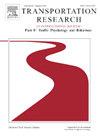Validation of motorized two-wheeler virtual environment: Influence of perceived realism and simulator fidelity
IF 3.5
2区 工程技术
Q1 PSYCHOLOGY, APPLIED
Transportation Research Part F-Traffic Psychology and Behaviour
Pub Date : 2025-02-01
DOI:10.1016/j.trf.2025.01.001
引用次数: 0
Abstract
The present study explored the behavioral validity and contributing factors to improve realism in the virtual environment. The driving performance of motorized two-wheelers was compared in a simulator environment and real-world conditions. The driving simulator featured a virtual environment created with Unity 3D software, designed to replicate the real-world road infrastructure and traffic conditions to simulate a mixed-traffic environment. The driving performance measures, including mean speed, lateral acceleration, and longitudinal acceleration, were used to evaluate the behavioral validity. The control factors considered for determining the relative validity were a) Road Geometry and b) Distraction due to pillion rider. The Bayes hypothesis testing was conducted to compare the differences in performance measures in a) high fidelity driving simulator with motion base platform, b) driving simulator without motion base platform, and c) actual field conditions. The results supported the relative validity of the driving simulator in both with and without motion-based platforms. This study further quantified the difference in driving performance using explanatory variables: a) Perceived realism, b) Prior exposure to the virtual environment, and c) Individual characteristics. The results showed that the hypothesis proposing consistent relative standard performance parameters between the riding simulator and real-world distracted riding situations was three times more likely to be true. The motion feedback systems marginally improved the speed perception by reducing mean speed by 7.4 km/h. However, other factors, such as the realism of sound and surrounding traffic, reduced the mean speed in the simulator by 16.3 km/h and 28.6 km/h, respectively. This study also indicated that extended familiarization sessions beyond the hardware control and dwelling into speed perception improved the realistic speed in the virtual environment by 11.47 km/h. Overall, this study achieves a relative behavioral validity of the motorized two-wheeler simulator and highlights the critical aspects to consider while designing the experiments in the virtual environment.
求助全文
约1分钟内获得全文
求助全文
来源期刊
CiteScore
7.60
自引率
14.60%
发文量
239
审稿时长
71 days
期刊介绍:
Transportation Research Part F: Traffic Psychology and Behaviour focuses on the behavioural and psychological aspects of traffic and transport. The aim of the journal is to enhance theory development, improve the quality of empirical studies and to stimulate the application of research findings in practice. TRF provides a focus and a means of communication for the considerable amount of research activities that are now being carried out in this field. The journal provides a forum for transportation researchers, psychologists, ergonomists, engineers and policy-makers with an interest in traffic and transport psychology.

 求助内容:
求助内容: 应助结果提醒方式:
应助结果提醒方式:


